Introducing Showrunner, the AI Platform That Lets You Make Your Own TV Show
First came AI’s Sora, which created video stories from voice prompts. Then came Suno, which wrote songs via AI. Now the latest AI platform to test Hollywood’s nerves is a streaming service where fans can use the technology to create an original episode of their favorite animated television show.
The new service, called Showrunner, first demonstrated its AI model by developing nine “South Park” AI episodes, which it released as an 11-minute compilation on X during the WGA strike last July. The post drew 8 million views, opening the door to meetings with Fox, Netflix, Paramount and Sony.
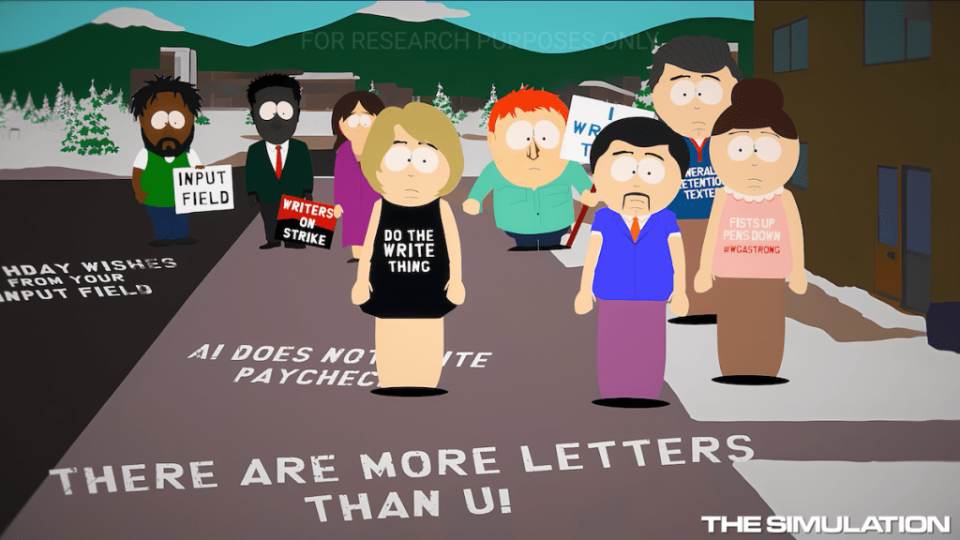
“We started talking with [the studios] about how do you actually let fans make episodes of shows using AI,” founder Edward Saatchi told TheWrap. “We’ve been talking with some of them about how revenue share would work. Maybe fans are making episodes of ‘South Park’ and it’s done in a way that nobody knows about until the studio has seen the episodes. And at the same time, we started to make original shows and started to work with users to make new episodes of TV shows.”
Fable Studio, a San Francisco-based production house that has won Primetime Emmy and Peabody awards for its scripted animation content, is behind the new offering, which Saatchi says is targeted at non-technical, non-professional users.
Saatchi declined to disclose the costs around the platform or how much financing Fable has, but he noted that the initial plan is to offer Showrunner for free later this year, and then introduce a subscription model later on. He envisions a future where Fable could partner with major streamers like Netflix on a paid add-on for subscribers to be able to make their own content using Showrunner’s capabilities.
As part of a formal product launch on May 30 announced on X, Showrunner unveiled a slate of 10 original animated shows, including “Exit Valley,” a satire of Silicon Valley leaders in the AI revolution; “Pixels,” a family comedy of AI-enabled devices living in the fictitious Sim Francisco; “What We Leave Behind,” an anime family drama about two orphans in Sim Francisco; “Ikiru Shinu,” a dark horror anime focused on the survivors of a global calamity trying to rebuild society; and “United Flavors of America,” a cartoon political satire of U.S. politics in 2024.
A “South Park” simulation
Saatchi was a founding member and producer at Oculus Story Studio, the VR animation studio that Meta shut down in 2017. After co-founding Fable in 2018, he went on to launch Fable Simulation, an AI-focused arm of Fable Studio, in 2021.
The Fable team made the “South Park” episodes without the permission of the animated comedy’s creators — solely for research purposes and with no intention of making the ability to create episodes of the show available for public use, the company said.
Announcing our paper on Generative TV & Showrunner Agents!
Create episodes of TV shows with a prompt – SHOW-1 will write, animate, direct, voice, edit for you.
We used South Park FOR RESEARCH ONLY – we won't be releasing ability to make your own South Park episodes -not our IP! pic.twitter.com/6P2WQd8SvY— The Simulation (@fablesimulation) July 18, 2023
When asked about potential copyright issues that could arise from making new episodes of existing TV shows, Saatchi said that while you can’t copyright a style of animation, you can copyright characters and stories.
“It would violate copyright for us to monetize and put a ‘South Park AI’ maker or ‘Simpsons AI’ maker out there without collaboration with the relevant studios and creators,” he said. “As the product opens up, if users are creating IP characters, we’ll do our best to take them all down and remove people who are releasing work that violates copyright.”
“South Park” creators Trey Parker and Matt Stone notably started their own generative AI deepfake company, Deep Voodoo, which was working on creating a full-length movie about Donald Trump deepfaking his image. However, the pair revealed in an interview with the LA Times that the project was ultimately scrapped due to the coronavirus pandemic.
Representatives for Parker and Stone did not immediately return TheWrap’s request for comment about the Showrunner episodes.
How the unions feel about Showrunner
For Showrunner to establish a partnership with a streamer, it would require giving notice and negotiating the economic terms with the WGA and SAG-AFTRA, and could raise the same concerns from the guilds about unauthorized replication of actors’ voices that they expressed in the strike negotiations last year.
“If we’re talking about creating new episodes of an existing series — even if it’s an animated series — if that series is voiced by actors, and if this technology is going to be used to replicate their voices for the consumer-created episode of that series, then they would have to have full informed consent and compensation paid to the actors whose voices are being replicated,” Duncan Crabtree-Ireland, SAG-AFTRA’s national executive director and chief negotiator, told TheWrap.
“If the idea is let’s create a wholly new concept that doesn’t use any human performance whatsoever, but is created by one of those companies, then there would be a negotiation with the union over the economics of that,” he said.
Saatchi acknowledged the Hollywood unions’ concerns that studios’ use of artificial intelligence could affect their livelihoods. He also indicated that he would be open to working with the guilds, noting that the point of Showrunner is to show that AI is a “powerful storyteller” and “encourage conversation about how that changes entertainment.” But he argued that the Showrunner platform is focused on using AI to assist creatives and the public in making their projects come to life, rather than on replacing them.
“Silicon Valley is always trying to tell Hollywood that their new miracle device will change everything. The reality is that as the great screenwriter William Goldman wrote ‘Nobody knows anything’,” Saatchi added. “AI for TV shows and movies may be the next big thing or the next web3 / VR and have very little impact on Hollywood. I hope that people don’t overworry because it’s super early and unclear what will happen.”
Netflix, Paramount and the WGA declined to comment about Showrunner. Representatives for Fox and Sony did not return TheWrap’s request for comment.
How Showrunner works
Showrunner is powered by Fable’s AI model Show-1, which was first introduced to the public in a research paper last year. Show-1 leverages a combination of large language models (LLMs), custom diffusion models and a “multi-agent simulation for contextualization, story progression and behavioral control,” according to the paper.
In a similar way to how tech companies have trained chat boxes and OpenAI’s Sora, Fable has used “publicly available data” to train Show-1, Saatchi said, meaning it is scraping the internet without seeking permission from individual copyright holders. It’s the same fair-use strategy all the tech companies have used to justify potential copyright infringement. Saatchi told TheWrap that the company is using AI “ethically” and “what matters (as it matters for all art) is whether a work is a copy or derivative or original.”
“We are focused on making original works of art,” he said.
For the purposes of the “South Park” experiment, the stable diffusion model was trained using approximately 1,200 characters and 600 background images from “South Park” and voice cloning technology was used to recreate the characters’ voices. Transcriptions of most “South Park” episodes are part of Open AI’s GPT-4’s training dataset, which eliminated the need for a custom fine-tuned model.
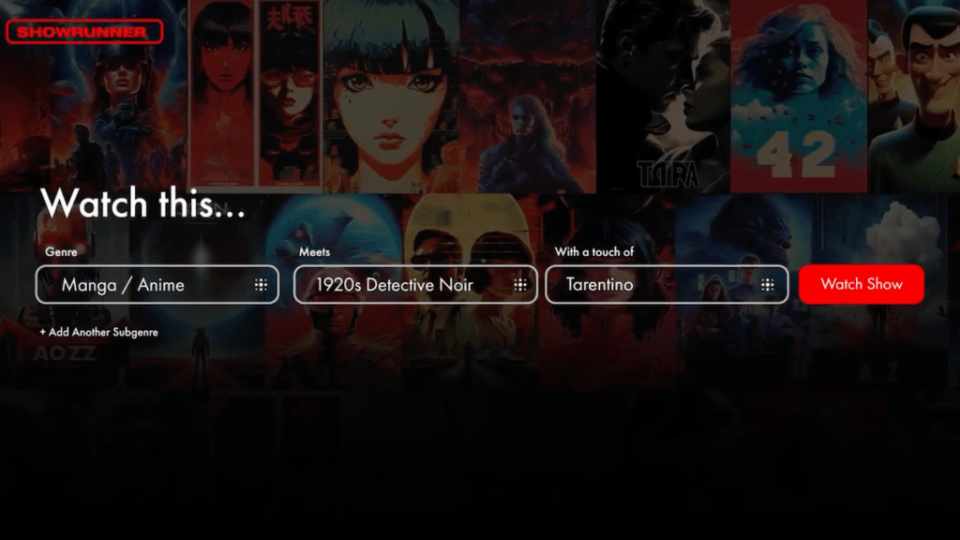
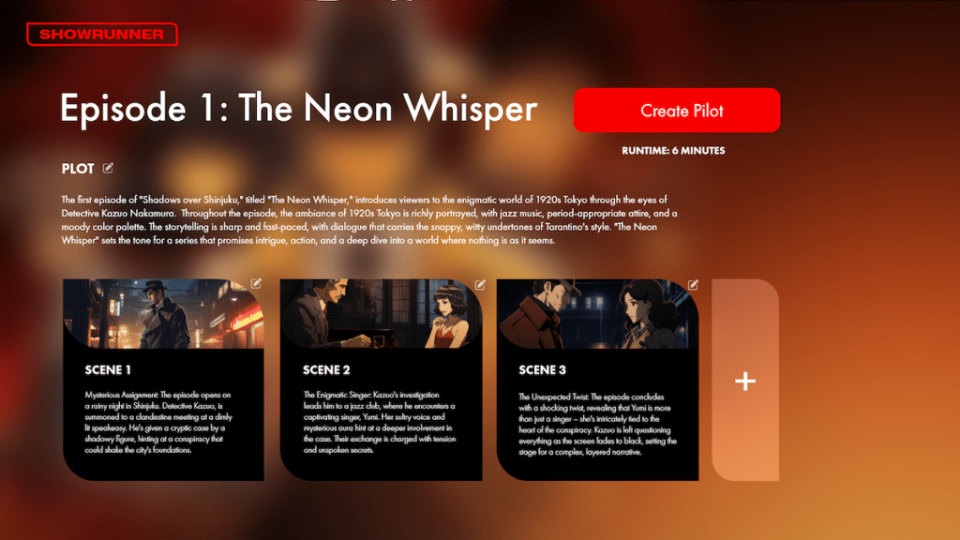
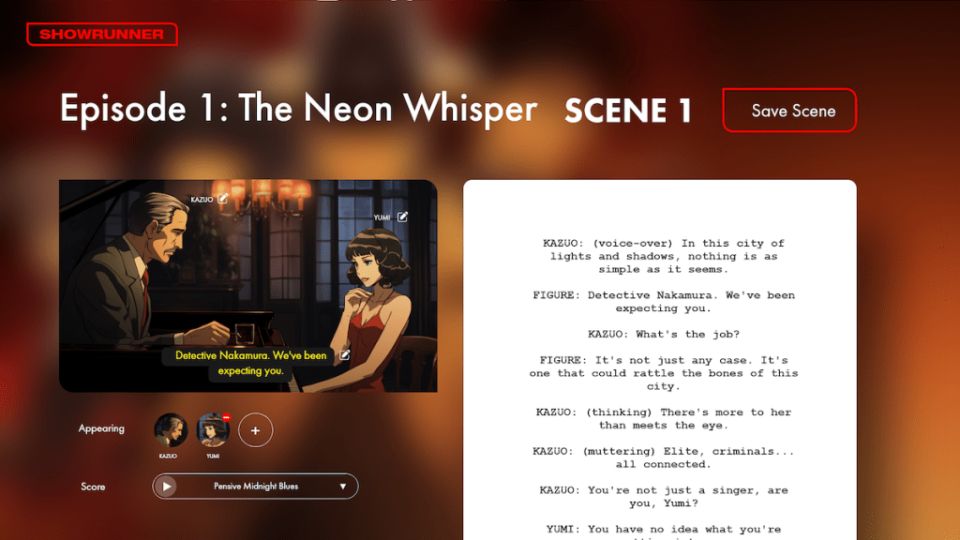
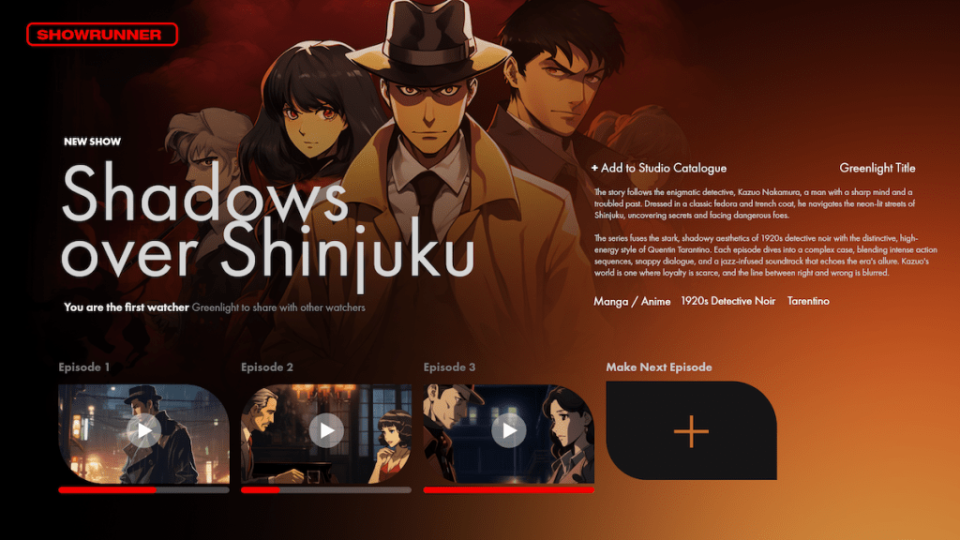
Using a user prompt of around 10 to 15 words, Showrunner can make full scenes and episodes of television ranging between two and 16 minutes, complete with AI-selected dialogue, voice editing, shots, characters and story development. Users can then choose to go into the episode or scene and edit the scripts, camera angles and voices to their liking, or even remake the episode. Showrunner is aiming for seasons that range between 10 and 22 episodes.
While the platform is being teased as the Netflix of AI, Showrunner still has limitations. It is only able to create animated shows, and it’s more suited to procedurals or sitcoms whose episodes reset with different storylines, rather than the multi-episode arcs of a show like “Breaking Bad” or “Game of Thrones.”
Entering the Alpha
The platform currently has over 50,000 “Alpha” users signed up for its waitlist, who are being let in daily to try out the platform for themselves with the goal of creating a broader roster of shows.
One of the first Alpha users given access to Showrunner was Dov Friedman, the co-creator of “Hutzpa!” Friedman and his collaborators Brian Gross and Sam Frommer have been developing the show on and off since 2011 but have struggled to get their foot in the door in Hollywood.
“One of the reasons why we did this is we want people who are creative who haven’t been able to get that shot to get that shot,” Saachti said.
Friedman’s team already has a lengthy pitch deck, filled with an abundance of characters and concept art. While they see Showrunner as an opportunity to develop the show further with an assist from AI, he insisted that using the tool will not replace the human touch.
“We hand drew these characters that are based off of people that we know. These are our stories,” Friedman told TheWrap. “AI is great to create and jumpstart things but there’s still ingenuity and there’s still the creativity of man that’s out there.”
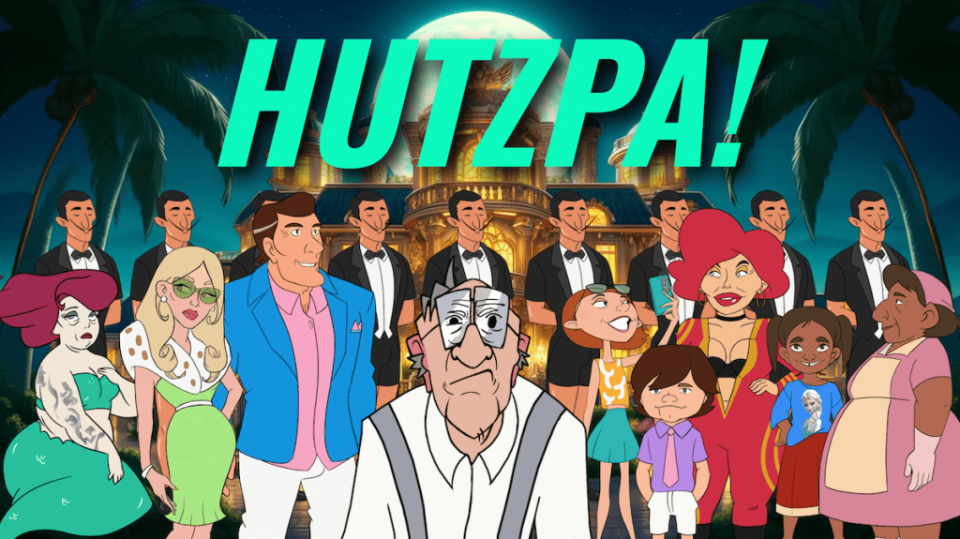
Saatchi and Showrunner, Friedman added, are allowing him to experiment with making a show without having to win the financial backing of a big studio.
“We don’t need to have a $150,000 budget per episode with 40 people working on it,” Friedman said. “We think that with Edward’s tools and then using some traditional animation, we’re going to get a show out of this.”
While “Hutzpa!” is being planned as a 10-episode first season with the hope for five seasons in total, “Exit Valley” is targeting 22 episodes in its first season, some of which are being made by Fable and others by platform users. A jury of filmmakers and creatives will select 18 episodes made by users at the end of July that will be considered canon to the first season of “Exit Valley.”
In addition to helping creators, Saatchi said he hopes Showrunner will lead to completely new content at a time when audiences are drowning in sequels.
“One of the experiences I’ve had is working with people from Pixar and from Dreamworks who felt that they were in a factory because it was so highly specialized, so complicated, that they weren’t able to express much creativity at all,” he said. “I’d rather see weirder stuff by people who are not beholden to making a $100 million movie or show.”
The future of Showrunner
While it’s still early days, Saatchi envisions a future where creators like Friedman and the average fan can get a cut of revenue for “guest episodes” of streamers’ IP that would be made with their permission and potentially picked up to help with subscriber retention. A second step would be the creation of an add-on within the major streamers’ own platforms where subscribers could pay an extra fee to make their own Showunner-aided content.
“Giving the 270 million Netflix subscribers, for $5 extra, the ability to interactively make new shows is pretty attractive and would help them fuel growth,” he said. “And for the streamers in the weaker position, they’re also very interested because they want to jump up a bit and have something unique.”
When it comes to user-generated content that leverages AI, SAG-AFTRA’s Crabtree-Ireland warned that controls need to be put in place to ensure that a person’s voice cannot be used without consent or appropriate compensation. The No Fakes Act, a bipartisan proposal that would protect the voice and visual likeness of individuals from unauthorized recreations from generative AI, is currently pending in the U.S. Senate.
“The reality is that thus far we have seen user generated content occupies a certain place in the entertainment ecosystem and the availability of AI tools for consumers and the general public is not necessarily going to change that,” Crabtree-Ireland said. “So we need to be cautious about it.”
“But it’s also important that we not let fear become paralyzing because we need to take appropriate action to channel all this technology,” he added. “All of this has to be implemented in a way that’s going to be human-centered or we’re not going to support it.”
The post Introducing Showrunner, the AI Platform That Lets You Make Your Own TV Show appeared first on TheWrap.

 Yahoo News
Yahoo News 
